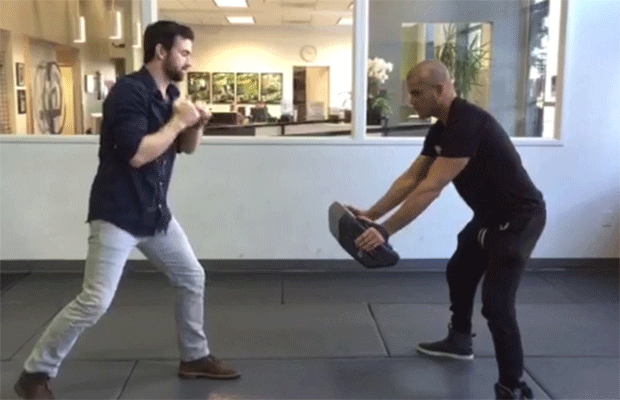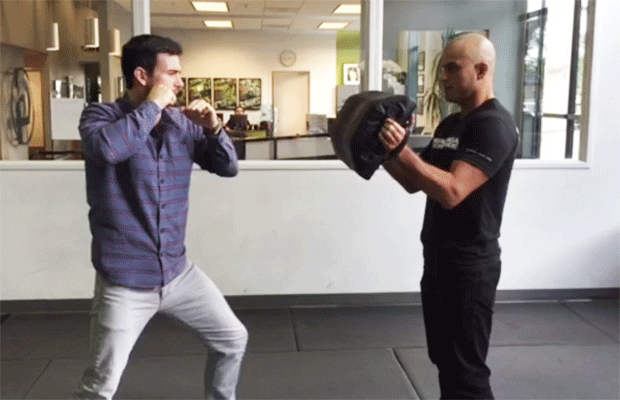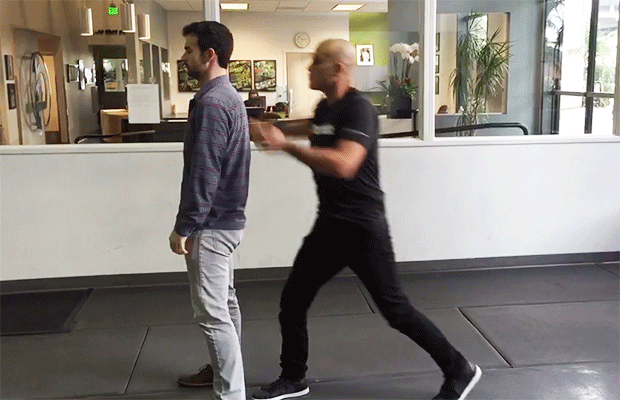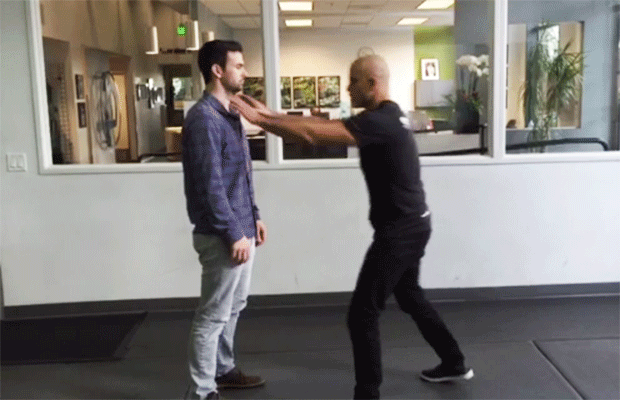
Spoiler alert: You don’t have to be especially big, strong or fast to protect yourself from an attacker. Even the shortest or slowest among us can learn a few basic moves to stay safe. Enter: Krav Maga, a self-defense system developed by the Israeli military. Combining elements of boxing, wrestling and MMA, Krav Maga is taught and practiced worldwide to prepare men and women for the unexpected.
RELATED: Train Different: 5 UFC Workout Moves for Beginners
“They come out of class and they feel like Jason Bourne.”
“All of the [Krav Maga] moves have an instinctive element to them,” says Matt Romond, a Krav Maga instructor and Vice President of Strategy for Krav Maga Worldwide. “It’s easier to learn them, and faster to recall them [if you’re] under stress.” The goal? Establishing self-defense as an impulse. “By the time you realize what you’re doing, you’re already halfway into the move,” says Romond.
Aside from teaching potentially live-saving skills (and being a great workout), Krav Maga can also be a huge confidence booster, Romond says. “Some people, when they watch a class, might be intimidated and scared,” he says. “But they realize that they can [actually] achieve this stuff. They come out of class and they feel like Jason Bourne.”
RELATED: 10 Ways You’re Sabotaging Your Workout
Want to feel more confident in your personal safety, no matter where life takes you? Grab a partner and practice these moves demonstrated by Romond. Afterwards, you’ll be unstoppable.
4 Shockingly Easy Self-Defense Moves

1. Front Kick to the Groin
Why It Works: “The groin is one of two areas on the body that cannot be conditioned to be stronger, and is therefore vulnerable to attack,” says Romond. A kick to the crotch can often cause abdominal pain and nausea. Translation: Your opponent will be doubled over in discomfort, leaving you to flee.
How to: Stand with your feet slightly wider than hip-width apart, facing your attacker. Your left, or non-dominant, leg should be slightly forward, with your right leg placed behind you. Raise your arms to your chest, like you are about to block a punch (a). Assess how high your attacker’s groin is. Raise your right leg, leading with your knee. Your hips should be pivoting slightly towards the attacker, to generate power from your core as you drive up with your leg. As your leg rises up, flick your lower leg so your shoelaces or your shin makes contact with the groin (b). Next, recoil to your original fighting stance so you can escape or continue to defend yourself (c).

2. Hammer Fist Punch
Why It Works: If you’ve never thrown a punch (or don’t do it often), striking with your knuckles can be dangerous — even causing you to fracture your hand. Instead, you’re better off using the hammer-like motion described below. “It’s very easy to learn and to recall during times of intense stress,” Romond says.
How to: Stand in a fighting stance, with your arms protecting your chest. Your right, or dominant hand, should be in a tight fist (a). Rotate your hips just slightly towards your attacker and raise your dominant hand up, bending at the elbow, like you’re preparing to throw a ball (b). Next drive forward with your hips and bring your right arm down, smacking your attacker in the face with the meaty bottom part of your fist (c). Recoil to your original stance and prepare to deliver another strike or to run away.
RELATED: 3 Fat-Blasting HIIT Workouts to Try Now

3. Defending Headlock from Behind
Why It Works: Getting attacked from behind can be scary because you can’t see or strike with strength right off the bat. However, this technique allows you immediately remove someone’s forearm from your throat and systematically work your way out of a headlock. Once you can face your attacker, you’ll be able deliver a strike to the face if you want, says Romond.
How to: If someone has their right arm wrapped around your neck, place both of your hands on your attacker’s hand and forearm (a). Tuck your chin to the left. Next, press your left shoulder into your attacker’s chest so you create some space between your bodies (b). Then, step your left foot between your bodies. You should now be able to duck your head under your attacker’s arm and wriggle free (c).

4. Defending Chokehold from Front
Why It Works: This technique can be carried out by someone much smaller than his or her attacker, says Romond. If someone is choking you from the front, your immediate goal is to remove his or her hands. “The [move] uses speed and momentum to overcome the attacker’s strength,” he says, noting that this technique should be paired with a swift kick to the groin to prevent your attacker from responding with more aggression.
How to: Raise your arms out the side and bend them into “hooks” (a). Dive your hands in the middle of your attacker’s arms and “pluck” your attacker’s wrists off your throat. Grab the thumbs and remove the hands from your windpipe by explosively twisting your attacker’s wrists away from your body. Your back muscles should be braced during this move (b).
Want to learn more Krav Maga moves? Head to a local academy or go at your own pace by checking out Krav Maga’s online courses at Krav Maga Worldwide, a new online academy.
